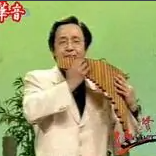Du Chong

Du Chong is a very talented performer in today's music scene. He is committed to the performing arts of various ethnic wind instruments. He is known as "the first flute of Shanghai youth" and "the first pan flute in Southeast Asia". The company's recording and blowing albums "Orchid in Spring", "1st to 15th" and "On the Rainbow", etc., have received unanimous praise.
He was born in a musical family in Shanghai. He loved the art of playing since he was a child. He began to learn flute playing from Zhao Zuotong and Dai Jinsheng at the age of ten. After graduating from junior high school, he entered the high school attached to Shanghai Conservatory of Music. Dizi players Lu Chunling and Zhao Songting, two masters, have come to the fore and formed a unique artistic style. His solid foundation and abundant creative talents make his performance unique. He became an excellent performer and graduated in 1985; in the same year he joined the Shanghai Chinese Orchestra as a solo performer. Later, he was transferred to the Shanghai Song and Dance Troupe and is now a solo performer of the troupe.
With his solid basic skills and creative performance skills, Du Chong has made remarkable achievements in the performance of flute, Xiao, Bawu, Xiang, Pan Xiao, Xindi and Hulusi and other wind instruments, which can be described as application in art. Free, self-contained. Du Chong's dongxiao performance is tender and delicate, melodious and lingering,
It is memorable and loved by the audience. In the pan flute playing, Du Chongyou won wide acclaim for his gentle, free and expressive performance, and was known as the "Pan flute prince".
Du Chong has visited the Netherlands, Belgium, France, Hong Kong and other countries and regions as a soloist for many times, and has been widely appreciated by the audience. In recent years, Du Chong has participated in the soundtrack performance of many film and television works, recorded more than ten laser discs and sound tapes, dubbed many films and TV films, and served as a solo or lead performance on the theme of music.
Du Chong is currently a member of the Chinese Musicians Association and a member of the Shanghai Musicians Association.
The little album titled "Love" (KG1019-2) released by Hugo Company includes all kinds of affection in life, and seems to be a condensed life story. Du Chong, known as "the first flute of Shanghai youth", was born into a musical family and received careful guidance from flute masters Lu Chunling and Zhao Songting. His skill cannot be underestimated. His delicate yet free and easy style deduces each piece of "Love" just right. Love comes and goes, deep and shallow self-knowledge, is a fixed number given by God. But in the ups and downs, few people have the courage to open up and let go. Even if I have suffered and cried for love, it is still a pain in the end.
Isn't that the feeling in "I Love"? It contains all the tastes of love: the heart of waiting, the ecstasy of getting, the sadness of losing, and the unrepentance of a lifetime. And He Zhanhao's "Farewell is Difficult" can't help but remind people of Li Shangyin's splendid song through the ages. Some of Teresa Teng's representative works "Small Town Story", "Sweet Honey", "Seeing the Smoke Again" are selected, either fresh and sincere, or sweet and gentle. Performed with a flute similar to the human voice, it is touching and intoxicating. In addition, the Inner Mongolian folk songs "Pastoral", "Bending Moon", "Late Autumn", etc. are all good music with infinite emotions. The standard of pretty discs in the minds of every music fan is different. No matter which category you belong to, you can't disagree, music that evokes pure aural beauty is more likely to be recognized by most people.
Therefore, after repeated listening, I decided to recommend this very nice Chinese light music record "Love" to everyone. As long as you look at the track, you will understand that it is not a cliché to say that it is very good: "What Can I Want in My Life", "Small Town Story", "Bending Moon", "Sweet Honey", "Late Autumn", "Let's Go Away"... ...I believe that the old men and women who have been over the years will still remember these popular tunes that were once all the rage. The extremely high popularity no longer requires me to introduce more about their audibility. It is worth introducing the two protagonists of this light music recording of the adaptation of popular songs. Du Chong, who is the flute theme soloist, is a talented and excellent performer in today's Chinese music scene. The arrangement and MIDI are completed by the famous Canadian composer Jiang Xiaopeng. He graduated He is currently a foreign teacher in the Composition Department of Shanghai Conservatory of Music. The experience of living abroad for a long time has made his artistic concept forward-looking, and the traditional cultural influence is the ultimate motivation and goal of his creation.
Du Chong's flute pays attention to the melodious lines, and the lyrical nature of the melodious flute is not much more condescending than the original vocals. Jiang Xiaopeng's arrangement is more delicate and careful than the original singing version, and it is much richer in both the sense of hearing and the scene. The use of MIDI has the subtlety of traditional Chinese music, and the coordination with the acoustic instruments is not abrupt. The whole record has a kind of chivalrous love and hospitality. Among the ten pieces of music, "Farewell is Difficult", "What A Life For", "Pastoral Song" and "Seeing the Smoke Again" are particularly outstanding masterpieces, and the artistic conception of the music is very well rendered.
Similar artist
Involving musical instruments
Involved portfolio
Involved news
Popular artists
- 01 Zhang Xiuyan
- 02 Chen Tao
- 03 Li Muliang
- 04 Zhu Changyao
- 05 Zhang Gaoxiang
 渝公网安备 50010702504639号
渝公网安备 50010702504639号